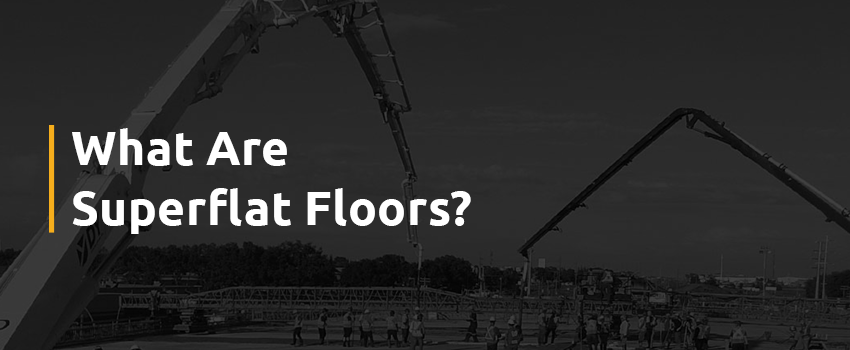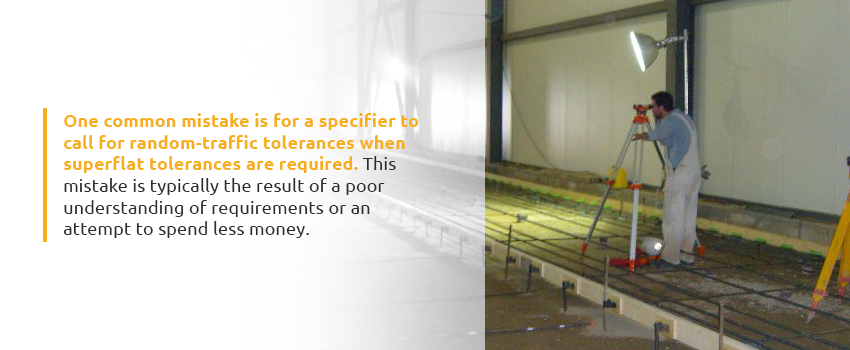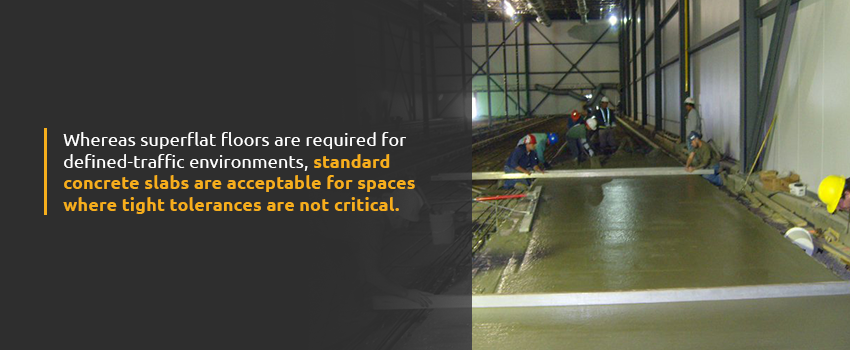
What Are Superflat Floors?
Posted By:Dynamic Concrete Pumping , Date: May 17, 2020

Concrete floors required to meet more demanding flatness and levelness specifications are known as superflat floors. They support lift trucks, material handlers and other vehicles that work at distribution and warehousing centers.
Superflat floors are popular for their low cost, high performance and safety benefits. They originated in the 1970s, when warehouse operators began to use storage configurations of higher density to minimize investments in land. These investments also helped optimize handling operations and the storage of materials.
Conventional construction methods are unable to create floor surfaces with the levelness or flatness that advanced lift trucks require for wire-guided environments with narrow aisles, high racks and defined traffic. For these environments, specialized construction methods that incorporate strip pour methods are needed.
Read more about superflat floors, their construction and specification and their usage.
What Is a Superflat Floor?
A superflat floor is built to a much tighter tolerance than a normal floor slab. To construct one, manufacturers use a specific tolerance system known as the Fmin tolerance system. This system is based on establishing a floor’s maximum variation for a particular lift truck.
The optimization of a surface provides multiple benefits, such as:
- Optimizing the lift truck’s performance.
- Reducing maintenance-related costs.
- Eliminating the chance of picking problems, including rack impact.
Builders can control highly accurate longitudinal and transverse tolerances by using specialized methods, materials and formwork to pour the concrete in narrow strips. Contractors must keep the following in mind when specifying and designing superflat floors:
- It is mandatory to strip pour: Strip pouring techniques are absolutely required for high-rack, narrow-aisle environments where AGVs, or automatic guided vehicles, are used. Otherwise, it is extremely difficult to achieve these demanding transverse and longitudinal tolerances.
- Superflat floors must not have transverse saw cuts: Shrinkage and curling can occur at transverse contraction joints, which can lead to tolerance losses and make superflat floors completely unusable.
- Floor tolerances need to be measured every day: Measurements must be made with highly sensitive profilograph equipment. If the tolerances are not measured daily, then any construction defects will unnecessarily worsen. Without a floor measurement, its surface quality cannot be certified.
- Fmin tolerances only apply to floors with defined traffic: The FF/FL F-number tolerance system is used for surfaces with random traffic, not defined traffic. The FF/FL system doesn’t address the transverse and longitudinal equipment tolerances.
- Make sure that the continuous steel embedded in the concrete is positioned correctly: Its location shouldn’t disrupt the guidewire electrical signals. Steel fibers have proven not to do this. They’re also durable, economical and versatile in that they can address a wide variety of user needs.
- Some dry-shake hardeners may not work: Certain dry-shake hardeners could prevent you from achieving superflat tolerances. Commonly used surface solutions depend on a concrete mix that is reduced wear with a 0.50 w/c maximum and a liquid densifier. For the liquid densifier, the right product will depend on the environment and require much careful consideration.
Superflat Floor Tolerances
Floor slab specifications in the U.S. often include the F-number system to determine the tolerances of a surface. There are two basic categories of floors:
- Random-traffic: The vast majority of floors in this country fall into this category. Pedestrian and forklift traffic can cross these floors in any direction without any trouble.
- Defined-traffic: These floors are generally only needed for very specialized applications, including VNA — or narrow-aisle warehouses — where forklifts must travel along the same path every day. Defined-traffic floors currently comprise a very small percentage of floors in the United States, although their popularity is growing due to owners becoming more aware of their benefits.
Forklifts in VNA warehouses travel down 6-foot-wide aisles between storage racks with the help of either a wide guidance system embedded in the floor or rack-mounted rails. The dimensions of the lift trucks themselves are around 5 feet wide and 7 feet long. When traveling down an aisle, a lift truck can raise its fork to place or retrieve products at various levels. For these lifts to work as intended, defined-traffic floors must be superflat.
Superflat Vs. Random-Traffic Tolerances
For contractors to build a superflat floor successfully, the floor needs to be specified properly. However, one common mistake is for a specifier to call for random-traffic tolerances when superflat tolerances are required. This mistake is typically the result of a poor understanding of requirements or an attempt to spend less money.
Sadly, practically no information is available to writers of superflat floor specifications. The American Concrete Institute and ASTM standards both offer little information on this subject. The lack of information can cause confusion.
The manufacturers of lift trucks do recommend certain floor tolerances to ensure that their equipment is operated properly. Unlike random-traffic floors, which have FF/FL requirements, superflat is a minimum tolerance and must be written using the Fmin system.
Fmin Tolerance Requirements
The Fmin system of measurement and tolerance definition requires that defects over the maximum allowed variation are corrected by grinding them down. The Fmin tolerance requirements for any floor surface are based on the maximum allowed rate of change per foot of travel for a lift truck in the longitudinal direction. You should obtain that information from the manufacturer of your lift truck.
Here are some examples of common Fmin tolerances:
- 0.040 inches: Fmin100
- 0.050 inches: Fmin80
- 0.060 inches: Fmin65
- 0.070 inches: Fmin55
- 0.080 inches: Fmin50
The higher the Fmin tolerance, the flatter and more level the floor is. Fmin100 is the most common tolerance, and Fmin50 is the lowest used. Because lift trucks travel the same route over and over again, the smoothness of the wheel paths in these aisles is extremely important. Superflat slabs are laid in narrow, long strips roughly 15 feet wide. You need to confirm the tolerance of the wheel tracks in the longitudinal and transverse directions.
The superflat Fmin100 tolerance is based on a change of 1/8 inch in elevation from a 10-foot-long level plane. The wheels on VNA lift trucks are usually 5 feet apart, which requires a tolerance of a 1/16-inch change in elevation. The tolerance is altered to correspond with the dimensions of the lift truck.
Common Specifications Errors
Because superflat floors must abide by specific requirements, there is more room for potential errors. Here are some common specifications errors that contractors encounter during superflat floor construction:
- Forgetting random-traffic floor specifications: A contractor should be aware of superflat floor specifications that need to be random-traffic specifications. Superflat slabs aren’t equally flat in all places, and tolerances are only determined in the wheel tracks in a single direction. Constructing a floor surface that achieves the Fmin100 (defined-traffic) tolerance in every direction is difficult and is comparable to creating a surface meeting the FF140/FL100 (random-traffic) tolerances. If these measurements include construction joints, it will be even more challenging. The floors of television studios require this kind of specification, although these floors are often over-specified. More realistically, floors that are random-traffic should be specified at a maximum tolerance of FF70/FL50.
- Considering F-100 and Fmin100 as the same: Specifiers and contractors need to understand that F-100 and Fmin100 are not the same concepts. Building a floor that is F-100 is considerably more difficult, and even if a contractor can build it, it may not meet the requirements of the owner. Some contractors will build a floor with a lower random-traffic tolerance to substitute for the Fmin100 tolerance in an attempt to save money. However, this decision tends to be a mistake. A better solution is to build a floor with a lower defined-traffic tolerance.
- Complicating costs: Some VNA lift trucks can operate properly on a floor surface that measures less than Fm100. When superflat floor construction was in its early days, the costs and construction methods were roughly the same for all superflat floors. This meant that a Fmin100 floor cost no more to build than a Fmin60 floor. As contractors have become more knowledgeable and experienced over the years, they have refined their methods and can now create a lower-tolerance superflat floor for a lower cost. Before a contractor bids for a project, they should have a strong understanding of how the tolerances of superflat surfaces will be determined. They should also be familiar with the equipment used to measure the tolerance.
- Confirming extraneous tolerances: Keep in mind that only the wheel track area of Fmin specifications needs to be confirmed. Confirming the tolerance of a random-traffic floor, on the other hand, is based on statistical information and measurements made at random. This information will not tell you anything about how well a lift truck will operate on a defined-traffic path.
Superflat Floor Applications
Superflat floors are used in many applications, including:
- Office buildings
- Stadiums
- Gymnasiums
- Ice rinks
- Production studios where camera dollies operate
- Distribution and warehousing centers where air-pallets are used
Superflat floor concreting needs may vary according to what application you plan to use. Dynamic Concrete Pumping has a division that specializes in superflat floor construction. We utilize the most cutting-edge equipment on the market, including the new Somero Laser Screed and the ride-on, 12-foot-wide Whiteman power trowels, which enable us to pour almost 80,000 square feet in a single day.
You may also prefer an environmentally friendly company that aims to set industry standards when it comes to environmental requirements. From our environmental hydraulic fluid to our cutting-edge concrete reclaimers, we are committed to finding solutions that treat Mother Nature kindly. Depending on your application, this may be important to your company.
Confirming Superflat Tolerances
To accurately measure random-traffic floors, there are several instruments available. However, it is not recommended that these instruments be used to measure defined-traffic floors. For defined-traffic floors, instead of a random sampling, each traffic path needs to be measured directly with a continuous-recording floor profilometer that is configured to run exactly in the tracks of the wheels.
As the profilometer travels along the path of the wheels, it records both the longitudinal and transverse differences in elevation of the wheels. The profilometer’s results don’t produce F-numbers but just confirm compliance with the minimum requirements. The profilometer produces a tape that lets the contractor know whether the surface is “in tolerance” or not. It also identifies the exact locations of any defects so that the contractor is able to grind down these places to comply with the tolerance.
There have been attempts to measure defined-traffic surfaces using equipment meant for measuring random-traffic surfaces. However, this generally does not work well because the equipment first has to measure information from each wheel track independently, which usually results in many errors. And the farther the measuring equipment travels from the starting point, the more errors will occur.
Imagine attempting to pinpoint and correct a location that is just a few thousandths of an inch out of tolerance but was measured from a starting point located several hundred feet away. By using a continuous recording profilometer, errors will be minimized because it measures differences in elevation as it rolls along the path.
Superflat Floors vs. Standard Concrete Slabs
Concrete floor standards differ from superflat floors. Whereas superflat floors are required for defined-traffic environments, standard concrete slabs are acceptable for spaces where tight tolerances are not critical. Standard concrete slabs comprise the vast majority of concrete slabs in the United States and are commonly found in places like:
- Manufacturing plants
- Hospitals
- Warehouses
- Shopping centers
- Schools
Standard concrete slabs are not subject to the Fmin tolerance system or other standards of superflat floors. They are normally found in random-traffic areas because forklifts and other traffic can travel at different times or paths each day.
Before installing a superflat floor or standard slab, it’s important to consider some key components of your environment. Specific environments might require a superflat floor, so understanding your location’s needs is critical before application.
These are some other considerations to keep in mind as you decide between the two options:
- The location and intended use: Think about the location for your flooring. If it features random-traffic, such as a shopping center or hospital, a standard slab might suit it better. However, if your environment has narrow aisles or VNA, a superflat concrete floor is most likely necessary.
- Floor flatness standards: Superflat floors have more stringent requirements for floor flatness. If you select a superflat floor, make sure you understand these additional standards before and after construction.
- Construction requirements: As explained above, a superflat floor’s installation follows specific requirements and flatness requirements. If you decide upon a superflat floor, remember the construction process will look different. You should conduct premeetings with the engineers, concrete manufacturers, concrete suppliers and other key members of the installation team. These professionals can help inspect your location and ensure you meet specifications.
Corrective Grinding
Creating a superflat floor without imperfections is impossible. Superflat specifications should permit the use of grinders to correct places that are out of tolerance. However, corrective grinding should be kept to a minimum and is only needed in the wheel path of lift trucks. Certain specifications allow for a maximum grinding amount of 15%. These percentages are based on the lengths of the aisles, not the individual wheel tracks. The average grinding amount is 3% to 5%, with the most experienced contractors grinding under 2%.
Apart from the contractor’s experience, the required grinding amount is also affected by the working conditions and the quality of the concrete materials. Areas that need to be ground are typically tiny and often only require the removal of just 0.010 to 0.020 inches.
Although these imperfections can be extremely small, they can be identified easily if the appropriate measuring methods are used. Contractors can avoid misunderstandings if the specifications are written down and properly interpreted. The contractor and specifier should both be familiar with procedures and standards. Regardless of how experienced a contractor or specifier is, they will not be able to meet expectations if the expectations are incorrect.
Contact Dynamic Concrete Pumping, Inc.
Dynamic Concrete Pumping Inc. is a Calgary-based concrete pumping and placing company with over 40 years of experience. We have built our business around knowledgeable staff and constantly update our equipment as technology improves.
We are part of a network of businesses that buys and sells used equipment. We are always updating equipment for our customers and selling our used equipment at reasonable discounted prices. If you need to lease or buy equipment in this industry, check out some of our great deals, and we can help you make the right choice for your application.
We have the capability to construct large concrete floors, and this is why Walmart, Target, Gregg Distributors and contractors alike come to us for their projects. If you need our services, contact us by filling out our form.





